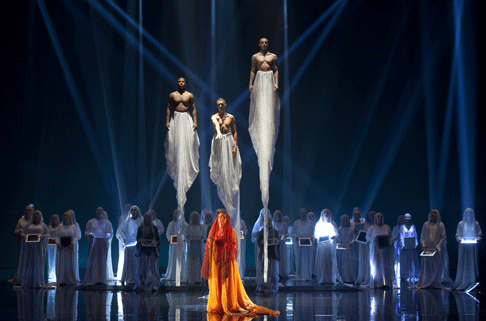This new production at The English National Opera, created by noted circus director Daniele Finzi Pasca proves that superlative staging can make up for weak narrative. Through visual images, the spirit of *L’Amour de loin* is invoked to express the drama beneath the music, better than the text itself.
Kaija Saariaho’s music wavers in a langorous swoon. Cadences rise and fall away, legato rippling upwards and down without regard to syntax. This is lavishly sensual, complete with faint echoes of the French medieval world of the troubadour, JaufrÈ Rudel (Roderick Williams), and the “Moorish” exoticism of Tripoli where the heroine ClÈmence (Joan Rodgers), resides. It’s the musical equivalent of intoxicating fumes, perfume or perhaps some strange potion inhaled through a hookah. Dramatic structure isn’t relevant to mood music as dream-like as this.
Love, after all, is an “altered state” where logic doesn’t apply, particularly in the case of idealized troubadour love, where artistic indulgence is as much an impetus as the love object. No wonder JaufrÈ panics and becomes fatally ill when he crosses the sea to meet ClÈmence for the first time. Unlike *Tristan und Isolde* where strong characters are transformed by a potion, to the horror of those around them, everyone in *L’amour de loin*, even the Pilgrim, is complicit in the dream state, so intensity dissolves in romantic washes of chromatic color.
Saariaho’s writing works best describing images like the ocean crossing, one of the most brilliant scenes in this production where light images are projected onto waving expanses of silk. It’s less suited to dramatic rationale. JaufrÈ and The Pilgrim debate endlessly whether he’s mad but the point’s already made in the music. Narrative meaning is further obscured by the distortion of natural rhythm and by dropping single spoken words into lines that are otherwise sung. Richard Stokes’s translation is lucid but retains the unworldly illogic of the original.
Roderick Williams, Joan Rodgers and Faith Sherman sing well, but this isn’t an opera where character development matters much. Its energies lie in the non-vocal writing, giving Edward Gardner and the ENO Orchestra a chance to luxuriate in lush orchestral texture.
The last scenes, where ClÈmence curses God, then quite quickly gives in to His will, might afford great opportunities for drama had the libretto engaged seriously with ideas. This is where the staging proved itself completely. As ClÈmence rages at God, Roderick Williams as the dead JaufrÈ descends from the roof on a wire, his white shroud trailing to the ground. At his side are the two “spirit JaufrÈs” who had been doubling him as he lay “dying”. Is it a reference to Christ flanked by the two thieves at the crucifixion ? Perhaps not, but the idea is just as sacrilegious as ClÈmence’s curse and vaguely logical in the same sense. But as pure theatre it’s undeniably dramatic. The stage is lit up in colors as gorgeous as the music, while the chorus shine searchlights upwards towards the ceiling. Gradually the number of searchlight beams increase until the whole auditorium is bathed in unearthly white light. Whatever the image may mean, it’s a magnificent statement.
 Joan Rodgers as ClÈmence and the spirits of JaufrÈ [Photo by Johan Persson courtesy of English National Opera]
Joan Rodgers as ClÈmence and the spirits of JaufrÈ [Photo by Johan Persson courtesy of English National Opera]
In an opera where ideas are so loosely defined, moments like this make all the difference. Finzi Pasca uses the specialist circus skills to extend the range of effects possible on stage. Acrobats dressed in strange headless garb “swim” in the air against a background of silk and colored lights. Huge planes of blue silk zoom onto the platform released on flywires from the upper balconies. Cutout transparencies and panels create illusions of space. Even the costumes act. Sleeves are made with huge silken extensions manipulated by actors, so it seems the singers are surrounded by huge, winged beings. It turns the opera into something truly magical.
Anne Ozorio
image=http://www.operatoday.com/Lamour_de_Loin012.gif
image_description=Joan Rodgers as ClÈmence [Photo by Johan Persson courtesy of English National Opera]
product=yes
product_title=Kaija Saariaho : L’amour de loin
product_by=Roderick Williams (JaufrÈ Rudel), Joan Rodgers (ClÈmence), Faith Sherman (The Pilgrim), Antoine Marc, Ted Sikstrˆm, Sara Lundstedt, Lilli M¸hleisen, Tamzen Moulding, Phillipa Anderson, (spirits), Robyn Simpson, Jami Read-Quarrell (shadow actors], Daniele Finzi Pasca (director, choreographer, lighting] Jean Rabasse (designs), Kevibn Pollard (costumes) Edward Gardner (conductor), Orchestra of the English National Opera
product_id=Above: Joan Rodgers as ClÈmence [Photo by Johan Persson courtesy of English National Opera]